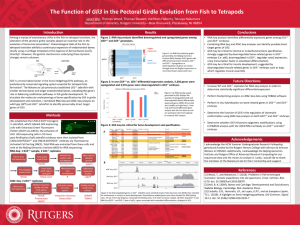Wei, Janet: The Function of Gli3 in the Pectoral Girdle Evolution from Fish to Tetrapods
Title: The Function of Gli3 in the Pectoral Girdle Evolution from Fish to Tetrapods
Name: Janet Wei
Major: Molecular Biology and Biochemistry, Marine Biology
School affiliation: School of Arts and Sciences
Programs: Honors College with Johnson & Johnson Women in STEM2D Life Sciences Summer Undergraduate Research Fellowship (HCW-SURF)
Other contributors: Thomas Wood, Thomas Stewart, Kathleen Flaherty, Tetsuya Nakamura
Abstract: Among a myriad of evolutionary shifts in the fish-to-tetrapod transition, the alteration of the pectoral girdle complex played an essential role in the evolution of terrestrial locomotion as the skull separated from the forelimb, creating the neck. Paleontological data of the fish-to-tetrapod transition exhibits a continuous expansion of endochondral bones (ossify using a cartilage template) at the expense of dermal bones (ossify directly), but the genetic mechanisms underlying these dynamic changes from fish to tetrapods remain unknown. To elucidate the genetic mechanisms underlying pectoral girdle evolution, we investigated the function of Gli3, a transcription factor in the Sonic hedgehog (Shh) pathway, in zebrafish girdle development. I performed RNA-Seq and ATAC-Seq analysis on wild-type (WT) and Gli3-knockout (Gli3-KO) zebrafish embryos at 55 hours post-fertilization to identify possible direct targets of Gli3. I then generated lists of differentially-expressed genes among the WT and Gli3-KO genotypes, particularly bone/muscle-related genes. The downregulation of such genes suggest that Gli3 may be critical for dermal/endochondral bone specification and muscle development in zebrafish. Our findings provide insights into the molecular underpinnings of bone specification in girdle development and evolution.
